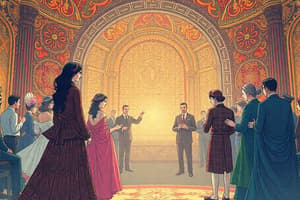Podcast
Questions and Answers
What is the primary focus of research in voting behavior?
What is the primary focus of research in voting behavior?
- Identifying motivations behind political activities (correct)
- Understanding the impact of economic factors on voting
- Analyzing historical voting patterns across different regimes
- Exploring the relationship between voter demographics and political outcomes
Which model emphasizes that voters remain loyal to their parties regardless of circumstances?
Which model emphasizes that voters remain loyal to their parties regardless of circumstances?
- The Michigan Model (correct)
- The Psychological Model
- The Rational Choice Model
- The Behavioral Model
Which voting model emphasizes that political preferences and actions are derived from group membership?
Which voting model emphasizes that political preferences and actions are derived from group membership?
- Psychological model
- Rational choice model
- Sociological model (Columbia model) (correct)
- Dominant ideology model
What typically influences party identification according to the Michigan model?
What typically influences party identification according to the Michigan model?
In which model do voters evaluate performance and policy platforms to further their own interests?
In which model do voters evaluate performance and policy platforms to further their own interests?
What is a key criticism of the models from the perspective of the dominant ideology model?
What is a key criticism of the models from the perspective of the dominant ideology model?
What is indicated by partisan dealignment in the context of voting behavior?
What is indicated by partisan dealignment in the context of voting behavior?
What significant change in voting behavior is described by the concept of class dealignment?
What significant change in voting behavior is described by the concept of class dealignment?
Which country exhibited the highest average annual change in partisan voters according to the data?
Which country exhibited the highest average annual change in partisan voters according to the data?
Which of the following was a shift in the methodology of studying voting behavior during the interwar period?
Which of the following was a shift in the methodology of studying voting behavior during the interwar period?
Which model, emerging in the 1990s, incorporates various approaches to understand voter behavior?
Which model, emerging in the 1990s, incorporates various approaches to understand voter behavior?
The potential dynamic of identity voting can be associated with which model?
The potential dynamic of identity voting can be associated with which model?
How stable is party identification compared to other political attitudes?
How stable is party identification compared to other political attitudes?
What was the main findings of the Michigan model regarding the party-switching behavior of voters?
What was the main findings of the Michigan model regarding the party-switching behavior of voters?
What is the relationship between voting behaviors and social group membership according to the sociological model?
What is the relationship between voting behaviors and social group membership according to the sociological model?
Which voting model critiques the idea that voters make their own decisions?
Which voting model critiques the idea that voters make their own decisions?
Flashcards
Voting Behavior
Voting Behavior
The study of why people vote the way they do and how political preferences are formed in democracies.
Party Identification Model
Party Identification Model
A model suggesting voters strongly identify with a political party and stick with that party, regardless of short-term factors.
Michigan Model
Michigan Model
A theory of voting behavior focused on party identification's role, originating in the 1950s at the University of Michigan.
Partisan Dealignement
Partisan Dealignement
Signup and view all the flashcards
Deductive Reasoning
Deductive Reasoning
Signup and view all the flashcards
Empirical Models
Empirical Models
Signup and view all the flashcards
Political Preferences
Political Preferences
Signup and view all the flashcards
Family Socialization
Family Socialization
Signup and view all the flashcards
Sociological Model (Columbia Model)
Sociological Model (Columbia Model)
Signup and view all the flashcards
Rational Choice Model
Rational Choice Model
Signup and view all the flashcards
Class Dealignment
Class Dealignment
Signup and view all the flashcards
Dominant Ideology Model
Dominant Ideology Model
Signup and view all the flashcards
Issue Voting
Issue Voting
Signup and view all the flashcards
Instrumental Voting
Instrumental Voting
Signup and view all the flashcards
Identity Voting
Identity Voting
Signup and view all the flashcards
Study Notes
Voting Behavior - Comparative Politics
- Voting behavior is studied to understand what motivates voters and who participates politically.
- The field acknowledges that findings about voting behavior are mostly applicable to democracies.
Main Questions of the Field
- What drives political activity in voters?
- Who engages politically and who does not?
- What shapes voting preferences and choices?
History of Researching Voting Behavior
- Early research (before the interwar period) leaned towards deductive reasoning.
- The interwar period saw collaboration between political scientists, economists, and behavioral scientists, leading to empirical models.
- Psychological research gained prominence in the 1990s and beyond.
Party Identification Model (Michigan Model)
- Developed at the University of Michigan in the 1950s.
- Key figures include Angus Campbell, Philip Converse, and colleagues.
- The model posits that voters identify with a specific party and generally vote for it consistently.
- Party identification is notably stable but not as strong as other factors (e.g., religion).
- Family socialization and early political experiences influence party identification, although other models offer more comprehensive explanations of voting preferences.
- Primarily based on the US political system.
Partisan Dealignment
- Partisan voters in several countries have shown a decrease, suggesting a shift in voters' allegiance to specific parties.
- Data from various countries supports this ongoing trend.
Sociological Model (Columbia Model)
- Developed at Columbia University in the 1940s.
- Key contributors include Lazarsfeld, Berelson, and colleagues.
- This model emphasizes the connection between voting preferences and group membership.
- Social groups tend to share common political predispositions.
- Key factors linked to voting behavior include group interests, opinion leadership, identity voting, and voting based on external features.
- Class-based voting has decreased since the 1980s.
Rational Choice Model
- Emerged during the interwar period, primarily developed by economists.
- Important figures include Hotelling, Downs, and others.
- This model underscores instrumental voting, where voters prioritize self-interest and policy preferences.
- Voter decisions are predominantly influenced by issues and policy choices.
- Voter choices are also shaped by personal interests and factors like identity.
Dominant Ideology Model
- Developed in the 1970s, it critiques existing models.
- It argues that voter choices are not entirely autonomous.
- The model emphasizes that elites and media play a significant role in shaping voter preferences and actions.
- Subconscious processes influence choices, informed by communication and education.
Psychological Model
- Originated in the 1990s.
- Key contributors include Marcus, Taber, and others.
- This model argues that emotional and subconscious factors significantly influence voter behavior, often rationalized after the fact.
- Political events often trigger quick and powerful emotional responses.
- Rational or group-based factors are sometimes less influential compared to emotion-driven reactions.
Studying That Suits You
Use AI to generate personalized quizzes and flashcards to suit your learning preferences.
Related Documents
Description
Explore the factors that drive voter engagement and political activity in democracies. This quiz delves into historical research, key models, and the psychological aspects influencing voting preferences. Test your understanding of how party identification shapes electoral choices.




